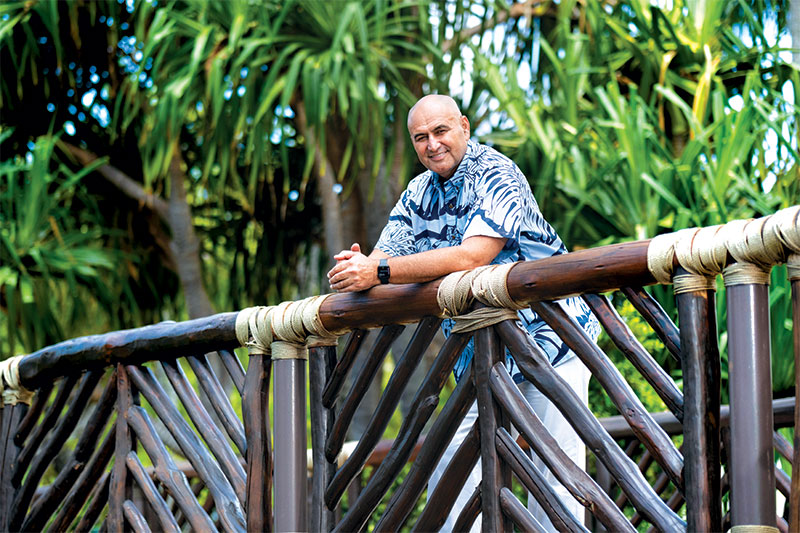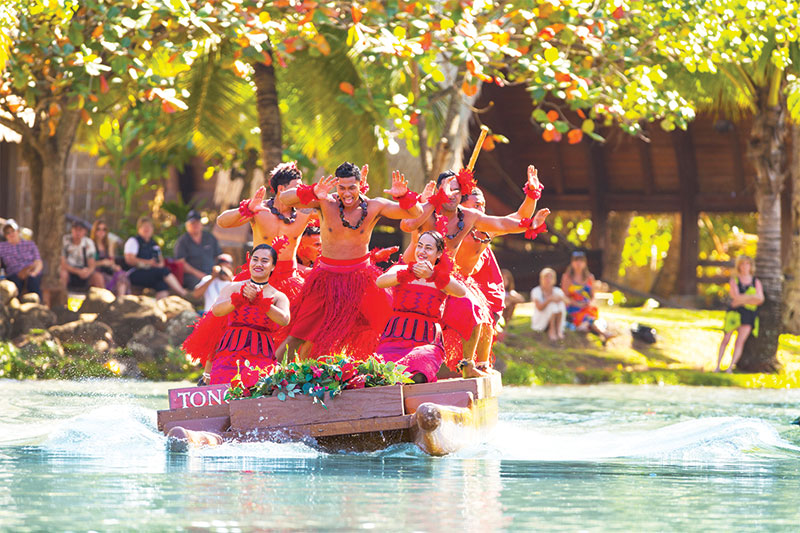The Center of Attraction

PHOTO BY ANTHONY CONSILLIO
With president and CEO P. Alfred Grace leading the way, Polynesian Cultural Center gears up for its 60th anniversary celebration.
When crossing paths with P. Alfred Grace for the first time, several of his attributes become immediately obvious. For one, he’s a man of large stature. For another, he possesses a lovely Kiwi accent. And for still another, he’s got a wonderful and active sense of humor.
The latter quality is apparent as he recounts the time a woman accepted his business card and straight away asked, “What’s the P in your name stand for?” Sensing an opportunity to spin a good yarn, he explained that his parents had given him the unusual moniker of “Palfred” at birth — a designation he grew to dislike. Once he was old enough, however, he quickly added a period and voila! Goodbye, Palfred — hello, P. Alfred.

Polynesian Cultural Center offers hundreds of students at Brigham Young University-Hawai‘i employment opportunities year-round. Many choose to work as performers in daily shows. PHOTO COURTESY POLYNESIAN CULTURAL CENTER
Grace was kidding, of course, but he never got around to telling the woman the real story behind his name.
“She was so sincere that I didn’t have the heart to tell her I was only joking,” he confesses. “So, somewhere out there in the world, there’s a woman who still thinks my name is Palfred.”
The truth is this native of New Zealand was given the full name of his grandfather — the P standing for Puataata. As he explains, pua means “to blossom” while taata refers to one’s spirit. In essence, his birth name was a promise that wherever he went in life, his soul would not only bloom but flourish, too.
“That’s what my mum said. I don’t know anything other than that, but I do know you never doubt your mother. She’ll always give you the positive,” he says.
Turns out Mom was as prescient as she was positive about her son’s future.
For the past decade, Grace has made a name for himself as president and CEO of Polynesian Cultural Center, the longtime tourist destination and entertainment hub that is preparing to celebrate six decades in business in October. (See story on page 16.) Since succeeding Von Orgill in early 2013 and becoming the first former Brigham Young University-Hawai‘i student and PCC employee to be named to C-suite positions, Grace has been instrumental in guiding the nonprofit through difficult periods while allowing the center — which employs some 1,400 residents, more than half of whom are students at BYU-Hawai‘i — to also flourish as an educational and cultural resource for the Pacific Islander community.
Despite his obvious impact on the center’s day-to-day operations, Grace downplays many of his accomplishments. Instead, he prefers touting the achievements of those who serve with him today, and crediting those who’ve mentored him in the distant past — “giants” such as Robert Iwamoto Jr., co-founder of Robert’s Hawai‘i; Leona Nakaahiki, former vice president of sales at Pleasant Hawaiian Holidays; and Ron Letterman, former head of American Express.
Modesty, it appears, is yet another one of Grace’s obvious qualities.
“If I’ve done anything good in my time here, it’s that, well, I’ve been surrounded by very good people,” he acknowledges. “They’re all very competent, all very passionate, all very committed. We have a good team.”
And yet, every good team needs a leader who guides and motivates members through challenging times. For PCC, Grace has been that person.
During the pandemic, for example, when the center was trying to find its way back after being closed for so long (an entire year) that, as its jovial leader jokingly puts it, “the grass had grown where we had emptied the lagoon,” Grace implemented a business plan that required a sizable shift in how things would be done.
Essentially, the bold proposal called for placing a ceiling on attendance numbers. No longer would the center sell each of the available 2,700 seats for its popular lū‘au, but rather keep daily accommodations to 400 guests. Likewise, instead of bringing in a seemingly unlimited number of diners to fill PCC’s largest restaurant, Gateway Buffet, Grace and his team put a cap on the number (800) of patrons.
While such a decision strikes at the heart of traditional business models that encourage profit-making opportunities at every turn, Grace says the new path forward meshed better with the center’s emphasis on quality over quantity, customer satisfaction over financial gain.
“From a business point of view, our management team knows how many people they’re catering for in a day,” explains Grace, who credits Letterman with floating the idea of capping attendance numbers to him more than three decades ago. “You don’t have to worry about cooking more chicken because you know there will only be 800 people today. Everything is geared toward achieving those numbers and doing it all correctly.
“To us, when you cap attendance and you also provide a satisfactory experience, it creates demand, and that demand pushes the online booking window well out,” he adds.
Beyond the improved experience for guests, the big winners at PCC continue to be its student-employees, many of whom work in one of the center’s Polynesian villages or as performers in nightly shows, and who remain as committed as ever to their 19-hour-a-week jobs.
As Grace observes, “They work hard, they dance hard and they serve hard during the lū‘au. On top of that, most of them are still carrying 15-18 credits in college.
“I really mean this sincerely, but the vast majority of these students are far more advanced than I was at their age,” he says. “They just seem to have their acts together a little bit more about where they’re going and what they want to accomplish. Yeah, you have the odd guys who are just enjoying life day by day, but then you have a lot of young people who see this as a huge commitment on the part of their families, particularly the international students, whose families are sacrificing so much to send their children to the university over here.”
All of which makes Grace proud to be a part of a financial promise that PCC makes to its student-employees.
“The commitment that we have with them is this: Between funding from our church and from private donors, and working here at PCC or at BYU-Hawai‘i, they can graduate with no debt,” he vows.
Grace has strong familial ties to the center, which first opened its doors to visitors on Oct. 12, 1963. Early on, his uncle, John Elkington, was given the assignment of constructing the center’s Maori Village and later served on PCC’s board of directors. Elkington was also the person who brought a young Grace to the islands for a vacation and wound up convincing him to stay by attending BYU-Hawai‘i. That was in 1983.
At the time, Grace wasn’t sure how he would pay for schooling, but fortunately, he possessed a rugby background that wound up having a financial perk.
“Once some people found out I played rugby back in New Zealand, I was offered what they called a talent award,” he says. “Now the university didn’t have rugby as a collegiate sport — it was a club sport — but they offered me a talent award and that covered my tuition.”
Initially, his goal was to graduate with a degree in business, return to New Zealand and begin work as a tour operator.
“I come from the central north island — we have a beautiful lake there along with hunting and fishing — and I felt that being a tour operator had a good future in that area, and it was something I thought I’d enjoy,” explains Grace, the youngest of four children who were raised on a farm in the small town of Tūrangi.
Those plans were interrupted after he met a fellow student from the Lā‘ie community, Valerie Enos, fell in love and became engaged. Marriage, however, was put on hold when he chose to serve a full-time mission in his native homeland for the center’s owner, the Church of Jesus Christ of Latter-day Saints. Following two years abroad, he returned to the islands, began working at PCC and made good on his promise by tying the knot with Enos.
“My first job at PCC was dancing in the night show and honestly, I didn’t care for it,” explains Grace. “But I did it because my wife, who was my girlfriend at the time, danced in the night show. She danced in everything.”
In contrast, Grace chose to limit his performances to the Maori and Fijian dance forms.
“I figured those were the manly ones and they weren’t too difficult for me,” he says, laughing.
Eventually, he moved from being a dancer and serving as a sales guide to accepting an account executive position based in Waikīkī. To his credit, Grace made the 35-mile trek from Lā‘ie to Waikīkī for 20 years — with the only interruption coming when he briefly took a position with Pleasant Hawaiian Holidays before PCC, in recognizing his value as a top-notch salesman, wooed him back.
Once Grace returned to the fold, it was only a matter of time before he was invited to move up in the operation’s ranks. In 2009, he gladly accepted PCC’s offer to be its chief operating officer, and four years later, to serve in his current roles.
In reflecting upon the last decade, Grace admits the years have been fruitful for him and his ‘ohana, which include three daughters, their spouses and their growing families. Yet apparently time hasn’t been kind to one of his finest features.
“It’s ironic that my first year as president and CEO was the 50th anniversary of PCC, and I had hair and everything,” he says with a grin. “Now, here I am 10 years later and it’s like, oh, my gosh.”
All jokes aside, Grace is elated to still be in a position where he can impact others’ lives for the better. In the end, one of his very best qualities is that he simply cares about others.
“Here at PCC, our goal is to continue focusing on providing worthwhile, unique and uplifting experiences that are cherished by our guests,” he says, “while continuing to provide great employment and learning opportunities for all of our employees and, in particular, our students.”
THE BIG 6-OH
When Polynesian Cultural Center officially turns 60 next month, it’ll be an opportunity for many former student-employees to gather once again in Lā‘ie.
The celebration won’t be as extensive as the center’s 50th anniversary jubilee a decade ago, yet more than 700 alumni are still expected to take part in the festivities. In fact, many will be flying in from around the world.
“It’s a reunion for us with alumni looking to meet up with their former classmates and coworkers,” explains president and CEO P. Alfred Grace. “They’ll also be working in our villages again and they’ll put on an alumni show, too.”
PCC has employed thousands of student-employees since opening to the public on Oct. 12, 1963 — nearly two years after its owner, the Church of Jesus Christ of Latter-day Saints, authorized construction of the nonprofit center. Its mission has been to preserve and share the spirit of Polynesia from six Pacific regions — Aotearoa (New Zealand), Hawai‘i, Fiji, Samoa, Tahiti and Tonga — with guests while also providing employment opportunities and scholarships for students at nearby BYU-Hawai‘i.
Since its debut, PCC has welcomed more than 42 million visitors to the 42-acre site it shares with the university. Over the years, visitors have been entertained and educated at the center, attending events such as the World Fire Knife Dance Competition, visiting villages to learn more about Polynesian culture, participating in a lū‘au and catching evening shows such as Hā–Breath of Life.
One of its main attractions, Huki: A Canoe Celebration, has been closed since spring 2020. But Grace promises that the parade of canoes showcase will make a much-anticipated return next summer.
“We’re looking at enhancing our Hawaiian experience over the next few years,” he adds.
To learn more about PCC and its October anniversary specials for members of ‘Ohana Club, a free kama‘āina loyalty program, visit polynesia.com or call 800-367-7060.

